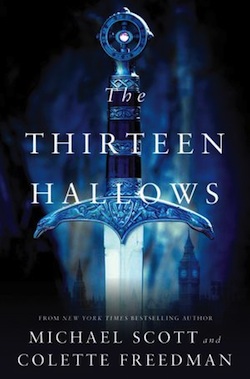Michael: I was introduced to the Hallows more than two decade ago when I started to research the character of Dr John Dee (1527-1608), for a horror novel I was writing. (Image, Warner Books, 1991).
Over the years, I returned again and again to Dr Dee and have written about him in several novels. Doctor John Dee was Queen Elizabeth I’s mathematician, astronomer and astrologer. He was an extraordinary man, well versed in all aspects of the occult and science (where often the dividing line between the two was very thin indeed.) He had one of the largest libraries in private hands in Elizabethan England and there is some evidence that William Shakespeare based the character of Prospero in The Tempest on him.
Dee’s family came from Wales and he was fascinated by the legendary hallowed—blessed—objects which weave in and out of Welsh and Irish myth. Soon, my research into Dee led me further back in time, as I began to research the thousand year old legends of the ancient hallows.
Colette: The first time I was introduced to John Dee was in Michael’s young adult series, The Secrets of the Immortal Nicholas Flamel.
I was captivated by Dee, who is a secondary character; yet, has so much chutzpah, he feels like the star of the story. John Dee is the anti-hero: a rogue, a notorious and powerful man who is incredibly likable despite his mischievous personality. My interest was further piqued when I learned that in John Dee’s correspondences with Queen Elizabeth, he would always sign his communiqués “007.” A long time James Bond aficionado who has seen every Bond film several times, I was thrilled to discover that John Dee was the original super spy.
Michael: Before they were called the Thirteen Hallows of Britain, they belonged to the Welsh legend cycle, The Mabinogion and were called Tri Thlws ar Ddeg Ynys Prydain.
The Mabonogion is a collection of myths, legends, fragments of history first written down in the White Book of Rhydderch and the Red book of Hergest in the middle of the fourteenth century. The stories themselves can be traced back to the eleventh century and some fragments are certainly much older than that.
There is no definitive list of Hallows—although the magical number thirteen is fairly consistent. Certain artifacts, like Dyrnwyn, the Chessboard and the Horn of Bran, appear in all versions of the stories.
When Geoffrey of Monmouth began to write the Historia Regnum Britanniae in the early part of the twelfth century, he essentially created the character of Myrddin Emrys: Merlin. It is at this point that the Hallows become wrapped up the stories of Arthur. The Grail and Excalibur, although never part of the traditional objects, are sometimes added to the Hallows.
Colette: When working with Michael on The Thirteen Hallows, we had great fun figuring out which of the hallows we would use in culling down our number to thirteen.
While most of the thirteen hallows play minor roles in the novel, both the sword and the horn are the “heroes” of the story. We loved the idea of giving our heroine Sarah the sword and forcing her to deal with the consequences of its power. Because the sword is a hallow which is generally linked to men throughout the centuries, giving it to a young woman who draws strength from its magic was a deliberate twist.
Michael: The other huge influence on this work is the poem The New Jerusalem by William Blake, first published in 1808. It begins with the lines:
And did those feet in ancient time.
Walk upon England’s mountains green:
And was the holy Lamb of God,
On England’s pleasant pastures seen!
The “those feet” in the text refer to the legend that Jesus Christ was taken to England by his uncle, Joseph of Arimathea and brought to Glastonbury. And Glastonbury is inextricably entwined with Arthur and the Grail.
In the early part of the twelfth century, a French troubadour, Chretien de Troyes, inserted Lancelot into the Arthurian stories. Chretien de Troyes’ final work also added the quest for the Grail to the Arthurian legends: Perceval, the Story of the Grail, forever enshrining the chalice as part of the hallowed objects.
Colette: Much of the research for this book was done on the ground in England and Wales. I met Michael in London where we crisscrossed the city, visiting all of the locations where Sarah and Owen traveled. (We even saw Oliver: the play which essentially ignites the story). Bath was certainly my favorite location and its quaint setting provided a fabulously serene environment for Judith’s cottage, and the site of one of the most important murders. We researched the location of the hallows, visiting Glastonbury and eventually traveling west to Wales where the novel’s finale is set.
Although the story is fiction, it is based rigidly on history, mythology and fact.
MICHAEL SCOTTis an authority on mythology and folklore, and the author of the New York Times bestselling series The Secrets of the Immortal Nicholas Flamel.He lives in Dublin, Ireland.
COLETTE FREEDMAN is an award-winning, internationally produced playwright. She lives in Los Angeles.











I have an issue with this book in that it is a wre write I read the Original in 1995 which had more gravitas than the current incarnation, in fact it felt a lot more real, this re working seems to have lost some of the flavor
and I would like to know why it was re worked,